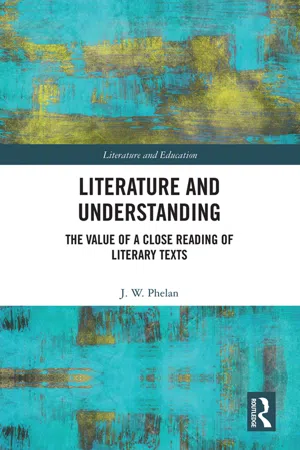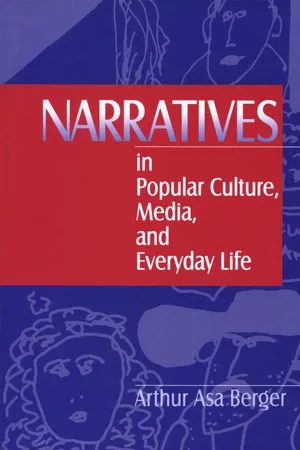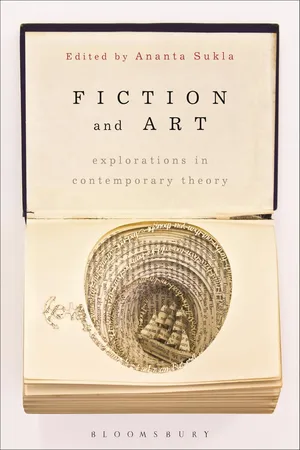Literature
Fictional Devices
Fictional devices are techniques used by writers to create a fictional world and convey their message effectively. These devices include plot, characterisation, setting, point of view, symbolism, and imagery. They help to engage readers and make the story more interesting and meaningful.
Written by Perlego with AI-assistance
Related key terms
1 of 5
4 Key excerpts on "Fictional Devices"
- eBook - PDF
- Christina Schoushkoff(Author)
- 2019(Publication Date)
- Society Publishing(Publisher)
LITERARY DEVICES CHAPTER 16 These are the principles and rules governing the structure of a multiparty linguistic interaction, a.k.a a conversation. They are easily applied in spoken dialogue as they are in a written one. There are nevertheless extensions to those regulations, which are used by the addressee and the addresser in order to stretch the meaning outside of the work frame, more specifically the conversational implicatures. They have been so propitiously implemented in language, that they have gained the status of a literary device. Ironically, literature is not the only their only residence, people use them in a day-to-day written and spoken conversations. Some of the literary devices are not typical only for the written works, in fact, we use them in the everyday conversations. The devices are predesigned operative ways of communication, which contain a specific conversational intention. They can surely be sifted through the conventional theories, but literature give a more approachable and practical outlook, that most users recognize. That being said, the following literary devices shall be reviewed as preconceived linguistic units, which literal and intended meanings are used as a communication tool with a clear structure, already analyzed and easily identifiable. 16.1. ALLEGORY Definition: An allegory is a symbolism device where the meaning of a greater, often abstract, concept is conveyed with the aid of a more corporeal object or idea being used as an example. Usually a rhetoric device, an allegory suggests a meaning via metaphorical examples. Semiotic Principles & Human Communication 146 Example: Faith is like a stony uphill climb: a single stumble might send you sprawling but belief and steadfastness will see you to the very top. 16.2. ALLITERATION Definition: Alliteration is a literary device where words are used in quick succession and begin with letters belonging to the same sound group. - eBook - ePub
Literature and Understanding
The Value of a Close Reading of Literary Texts
- Jon Phelan(Author)
- 2020(Publication Date)
- Taylor & Francis(Publisher)
The cognitive gain from reading literary fiction as literatureI argue, in Chapter One , that literary fiction is a subgenre of both literature and fiction as literary fiction possesses the standard features of both literature and fiction and lacks the contra-standard features of both super-genres. One standard feature of literary fiction as literature is the presence of what are known generally as ‘literary devices’. My contention is that literary devices play a crucial and neglected role in a reader gaining cognitive advantage from literary art. What do I mean by ‘literary device’? Literary devices do not form a quasi-natural kind like ‘culinary fruit’ or ‘extreme sport’ so I shall adopt a non-essentialist approach to categorising literary devices consistent with the approach taken throughout this work. In fact, the term ‘literary device’ can be substituted for ‘game’ in Wittgenstein’s famous passage from Philosophical Investigations I.66:Consider for example the features we call “literary devices” … What is common to them all? – Don’t say: “There must be something common, or they would not be called ‘literary devices’” – but look and see whether there is anything common to all. – For if you look at them you will not see something that is common to all, but similarities, relationships, and a whole series of them at that.Literary devices form an extended family where there is variation in resemblance between the likes of: onomatopoeia, symbolism and omniscient narration. So, we may conclude along with Wittgenstein (PI - Arthur Asa Berger(Author)
- 1996(Publication Date)
- SAGE Publications, Inc(Publisher)
Authors often speak to readers in indirect ways. When authors offer descriptions, through their choices of nouns, verbs, adverbs, and adjectives they are actually speaking to readers, telling them what they should think about certain characters or events. Descriptions and the figurative language found in them (and the other techniques authors use) give readers considerable amounts of information, as we shall see shortly.Readers must always keep in mind that, as Yuri Lotman (1977) has noted, nothing that happens in a text is irrelevant or accidental. This point has also been made by Aristotle, as a matter of fact; he suggests that if we take one thing out of a well-constructed work, it will suffer. A great deal of what authors do when they write stems from their psyches and functions at an unconscious level, so often writers can’t explain why they used this word rather than that one or had a character do X instead of Y. That is the task of critics.Many of the devices found in popular literary works can also be found in narratives in other media, such as film and television, though sometimes the devices take somewhat different form—for example, what we can see on the screen in a movie takes the place of a written description. In some cases devices are used in tandem, so that, for example, we get a summary that is also a confession, but it is usually possible to determine which device is basic. I will discuss below in turn the following common authorial devices:- Descriptions
- Thoughts of characters
- Dialogue
- Summaries
- Characterization
- Stereotypes
- Overheard conversations
- Letters, telegrams, and other correspondence
- Articles from publications
- Phone calls
- Confessions
DescriptionsDescriptions are one of the most important means through which authors give us information. They tell us what characters look like and how they behave, help situate actions, and generate feelings and attitudes in readers. Let me offer an example from The Maltese Falcon- eBook - PDF
Fiction and Art
Explorations in Contemporary Theory
- Ananta Ch. Sukla(Author)
- 2015(Publication Date)
- Bloomsbury Academic(Publisher)
Etymologically, fiction, the fictional, and fictionality allude to a kind of shaping closely connected to figuring, feigning, creating an image or similitude, hence imitating; and more distantly to kneading bread, building a wall, hence being enclosed (in a paradisiacal garden, for example), and touching. If literature designates a mode of writing, the fictionality in and of literature would name a meta-level aspect of this writing. It would hint at what literature does or 229 Fiction and Art 230 enables to happen: by its figurative resources and touching effects, fictionality extends and intensifies the shaping power of literary language along with the reach that literature makes possible.
Index pages curate the most relevant extracts from our library of academic textbooks. They’ve been created using an in-house natural language model (NLM), each adding context and meaning to key research topics.



